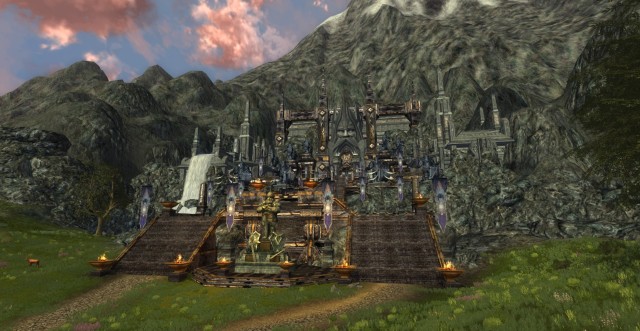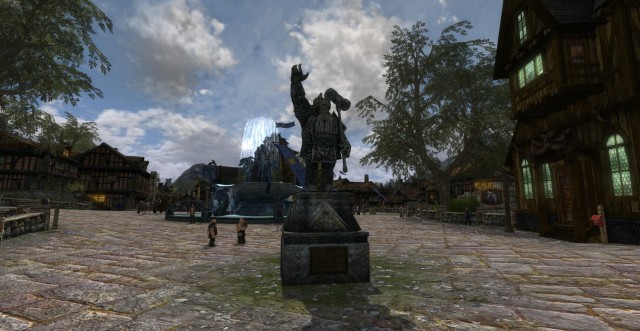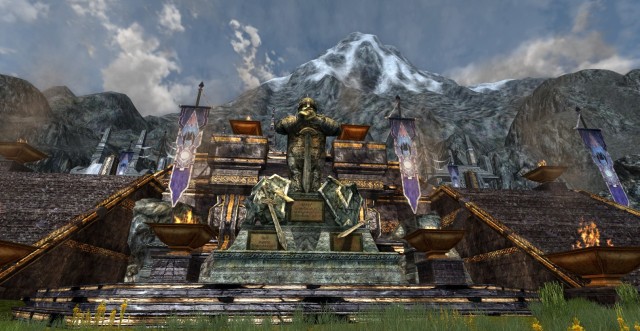As a few of you may know, when I’m not working on the dwarvish dictionary, replying to some of your wonderful Tumblr questions, or posting other material available through www.dwarrowscholar.com, I greatly enjoy roaming LOTRO, Middle Earth as created by Standing Stone Games.
So, naturally, when I heard an Erebor region was to be added in the next update (Update 22: “Legacy of the Necromancer”), I could hardly wait. In fact, it turned out I could not wait at all, as I ended up heading to the test server, known as Bullroarer.
To say I’m of a fan of this game is a slight understatement really. Not only has it been a staple for me these past years (apart from the much-needed family outings and sampling my whisky collection, likely my go to “unwinder”), but it has even given inspiration to quite a few of the words you’ll find in the Neo-Khuzdul dictionary.
Great and pleasant was my surprise when, roaming the lush fields at the foot of Erebor, I stumbled upon a grand memorial for Thorin and his nephews Fili and Kili (in addition to the statue of Dáin Ironfoot in Dale). Well, to be clear, the surprise wasn’t the memorial, but the fact that the plaques on the memorial seemed to make use of the words seen in the Dwarvish Dictionary.
When I had a closer look, I could clearly identify and read the words written here. Some of these were general Neo-Khuzdul, others specific to the version I had made. At the same time, I noticed a few minor mistakes in the runes used (specific runes and types of runes) and in the words themselves. So, I sent the good people of Standing Stone Games an email with some suggestions to improve and correct these plaques.
I thought nothing more of it after that, to be honest, and went back to my dwarvish business. A few days later though, I got a nice reply in which my suggestions seemed to be greatly appreciated. Before long I was having an enjoyable email exchange on the topic with Chris Pierson, LOTRO’s World Designer & Loremaster.
Long story short, the plaques were updated and in the process of doing so, LOTRO artist Mark Lizotte achieved a new level of Nerd-dom. My congratulations Mark. 🙂
For those interested in what the plaques actually say, here’s a screenshot with translations below.
Now, all we need to do as die-hard dwarf-aficionados is hope for a few more of those dwarf -themed regions in LOTRO in the years to come.





Great read. Thank you for the post. I have one question for you and this may sound naive but I thought the Hobbit fandom referred to Fili and Kili’s father as “Vili”. This is the first time I’ve seen the name as Kalin. Do you know where this came from? Just curious. Thanks!
LikeLike
Tolkien never specified the actual name of Fíli and Kíli’s father, so Kalin is as good as any of course. Though Víli is used by many in the fandom it would be rather an unlikely name. Reason for this is that “V” in names of Old Norse origin would have likely been written as “W” by Tolkien, if we take the names of the Völuspá as the standard, for instance, “Dwalin” originally is “Dvalin” in the Völuspá (where Tolkien got the majority of his dwarvish outer names). So using the fandom name and following that logic his father would have been Wíli, not Víli. Hence, Víli is rather an unlikely name for their father. Furthermore Kalin, like other Old Norse names has a rather interesting meaning to it, most likely derived from “Kala” (to be cold) – perhaps Kalin wasn’t the most affectionate of dwarrows?
LikeLiked by 1 person
O great and wise Dwarrow Scholar,
Your work is beyond impressive, yet here I believe I have found a discrepency. In your wonderful “Annals of the Dwarves”, you refer to one of the Dwarves clans as “Vigdis’s Folk”. I think I got that name right. How could the Dwarves used this? You are correct that “V” was often pronounced “W”, this is true in Latin as well, so I hope it is possible to correct this somehow. “Wigdis’s Folk” just doesn’t have the same ring.
LikeLike
Well met Dwamli,
Thank you for those kinds words.
I did consider this, putting the name is as “Wigdis” in the Annals of the Dwarves, but decided to keep it as Vigdis.
Reason for this was to keep the wink to the Old Norse name in there, like Dwalin is Dvalin in the saga’s, etc… AND to ensure that the name used by MERP (where this came from) was kept, a name lotro also used in their booklet for Moria.
Hence, I stuck with Vigdis and not Wigdis, but both are of course a rendering of the same name, one the Old Norse rendering, the other keeping into account Dwarvish.
The Annals of the Dwarves does need an update though (to include the latest information seen in lotro’s last two updates), so I might actually review these names again as some point.
After all, you make a good point on consistency that I didn’t think of at first. Either I should go with Old Norse rendering throughout the book, or keep it in line with dwarvish.
LikeLike
Thanks, great explanation.
LikeLike
Could you please explain, why the names of Fili and Kili are written as Fyli and Kyli on the plaques in LOTRO? It might be an obvious thing, but I just started with the alphabet and am a bit confused.
LikeLike
It is because their names are Fíli and Kíli (not Fili and Kili) and in this mode the “y”, represents the “í” (or long i), hence Fíli and Kíli is written as Fyli and Kyli.
LikeLike
Pardon me again, but I thought that the rune י stands for the long i. According to the alphabet on your website y reads as j in German “Joch”.
LikeLike
That is indeed correct, however this “y” rune also doubles an alternative for “î”, and in this mode of Erebor would (for names especially) be a valid alternative and the preferred style even.
LikeLike
Thank you so much for your answer!:)
What is this mode of Erebor you are referring to and how is it different from the standard?
Also, would the names look different written in Moria Cirth?
P.S. I truly admire your dedication to the subject and the amount of work you put into it. Your blog and YouTube videos the the only reliable source for thousands of fans around the world. I don’t know what would we do without you. Akhminruki astû! (hope I got that right)
LikeLike
That’s great. However, I do have an issue. In Tolkein’s work, Fili and Kili were always referred to as sons of Dis. To my knowledge (which isn’t perfect) their father’s name was never mentioned. Where did their father’s name come from? I would think being that their mother was the “ranking” family member, and that I’ve never seen their father’s name on any family tree including Tolkien’s works, that they should have been referred to as son’s of Dis.
LikeLike
You are indeed correct that Tolkien never mentioned the name of Fíli and Kíli’s father. I do not know with certainty why SSG opted to add a name for him here (not my idea, I merely checked the runes and patronymic form – which were correct), but I can only assume that they followed the pattern seen in on Balin’s tomb, where the patronymic name is used as well. I think we must not forget that if it were not for the valiant deaths of her sons in the Battle of the Five Armies Dís would not be named at all in the family history even. So I personally would agree with the choice of SSG here to use a patronymic instead of a matronymic (which we have no proof of even existed in dwarvish culture). Because, of course, it is one thing to name a dwarf woman in a family tree, but another matter entirely to add a matronymic to a dwarf – which, I personally think, would be a bigger leap from lore than just to invent a name for their father.
LikeLiked by 1 person